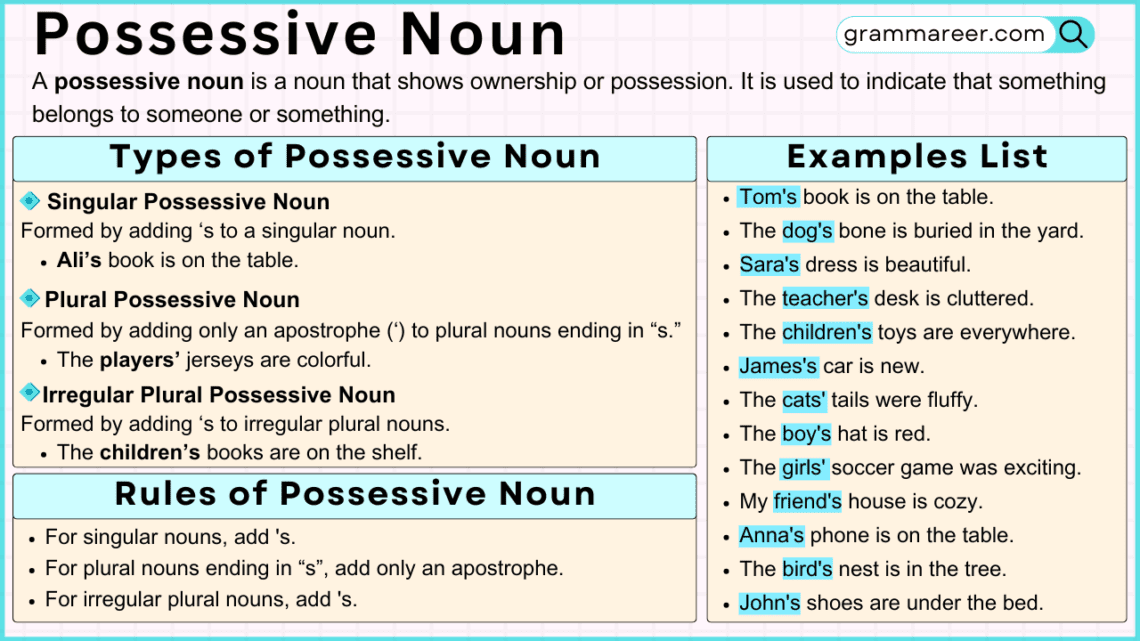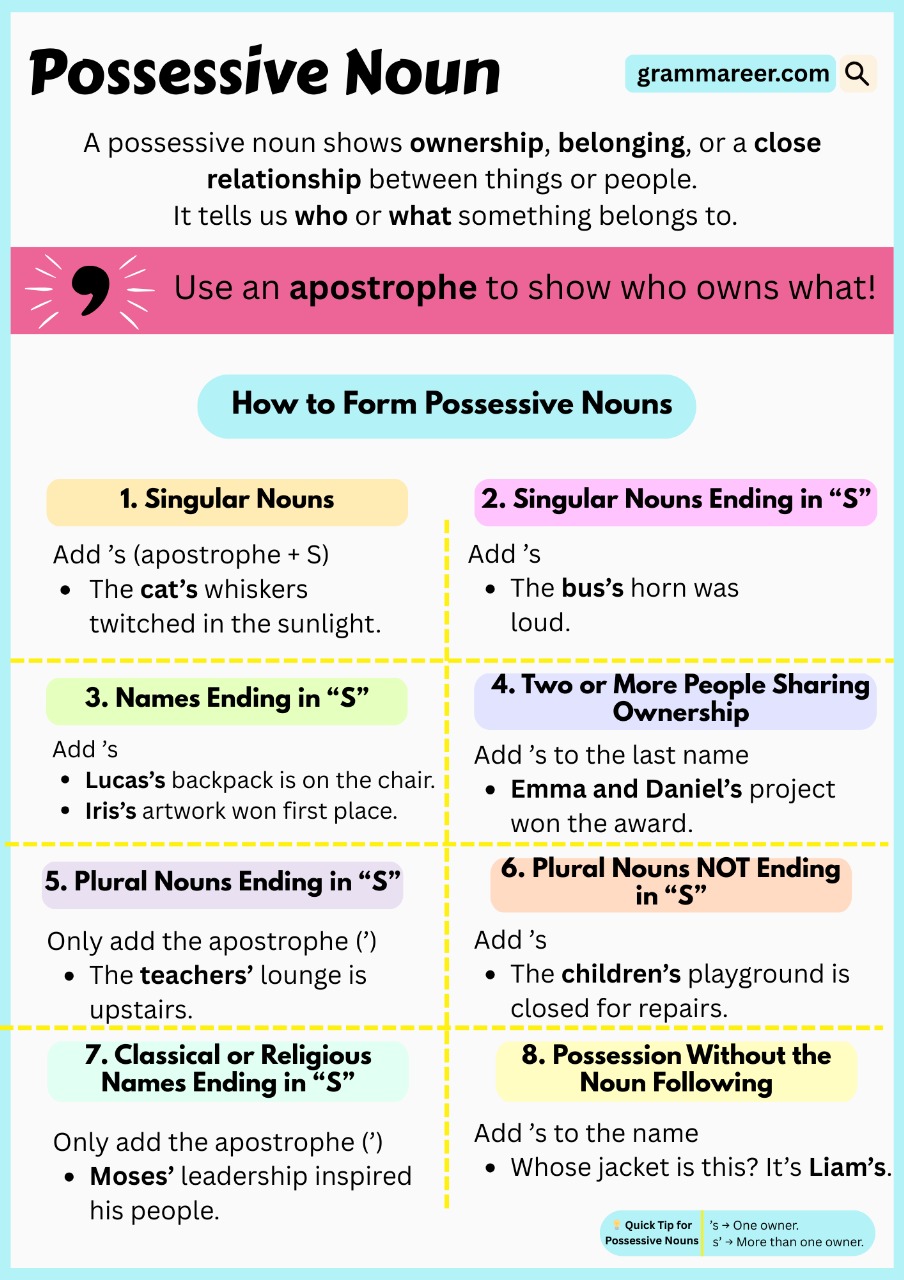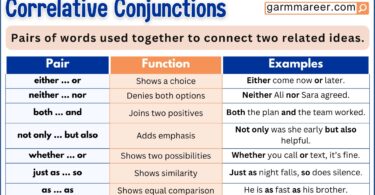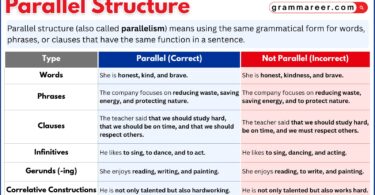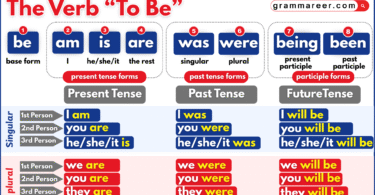A possessive noun is a noun that shows ownership or possession of someone or something. It’s usually formed by adding an apostrophe (‘) or an apostrophe plus s (‘s) to the noun. For example, in Ahmed’s car, it’s clear that the car belongs to Ahmed. Possessive nouns are an essential part of English grammar, helping you make sentences clearer and more precise.
By the end of this guide, you’ll feel confident using possessive nouns. We’ll explain what they are, when to use them, and share simple examples to make learning easy.
A possessive noun shows ownership, formed by adding ‘s or just an ‘ to a noun.
Table of Contents
What Is a Possessive Noun?
Possessive nouns are nouns that are used to show ownership or a direct connection to something. It just a way that show something belongs to someone or something.
Let’s say someone points to a bag and asks, “Whose bag is that?” You might say, “Jessica’s bag.” That little ’s after Jessica tells you it belongs to her. Most of the time, you make a noun possessive by adding an apostrophe + “s.”
How Do We Use Possessive Nouns in Sentences?
There are three main ways to use possessive nouns in sentences:
- Before another noun: First, they can come right before another noun, kind of like saying my or your. Here, they describe the thing or person that’s owned.
Example:- Eman’s dress is stunning. (Eman’s comes before dress to show who owns it.)
- Independently: in this case, possessive nouns still show ownership, even without naming the thing directly. Even when they stand alone, they point back to a noun already mentioned or obvious from the context, much like mine or yours.
Example:- That sandwich is Sarah’s. (We know sandwich is the thing Sarah owns, even though it’s not repeated.)
- With Compound Nouns:When a compound noun (a noun made up of two or more words) shows ownership, we add the apostrophe + s to the last word of the compound. This is because the last word is the “main” noun that carries the possession.
Example:- My sister-in-law’s bakery just opened downtown.
Indicating possession with “of”
An apostrophe isn’t the only way to show possession in English. You can also use phrases with the preposition “of.” This method works best in two situations.
If the owner is an object or an idea—not a person or an animal—it often sounds smoother to use “of” instead of a possessive noun. Sometimes the possessive form works fine, but the “of” version usually feels more natural. And in some cases, especially when it’s a well-known phrase, the possessive noun just sounds awkward:
- ❌The house’s roof.
- ✅The roof of the house.
- ❌The sky’s color.
- ✅The color of the sky.
Indicating Possession for Multiple Nouns
When more than one person (or thing) owns the same thing, you only add the apostrophe + “s” to the last name in the list—not to each one.
Example:
- ❌ Zahra’s and Ahamad’s parents searched for them for three days without success.
- ✅Zahra and Ahamad’s parents searched for them for three days without success.
Possessive Noun vs. Possessive Pronoun
Though similar, possessive nouns and possessive pronouns serve different roles. A possessive noun uses a noun to show ownership, while a possessive pronoun replaces the noun.
| Aspect | Possessive Noun | Possessive Pronoun |
|---|---|---|
| Definition | Shows ownership with a noun | Replaces a noun to show ownership |
| Examples | Zainab’s dress | Hers |
| Usage | Requires an apostrophe | Does not use an apostrophe |
Examples:
- Possessive noun: Bilal’s bike is new.
- Possessive pronoun: The new bike is his.
Types of Possessive Noun
Understanding these types helps in correctly identifying and forming possessive nouns.
1. Singular Possessive Noun
This is when one person or thing owns something. We add ’s to the end of the singular noun.
Examples:
- Ali’s book is on the table. → The book belongs to Ali.
- The cat’s whiskers are long. → The whiskers belong to the cat.
2. Plural Possessive Noun
When the noun is plural and already ends in s, we just add an apostrophe at the end.
Examples:
- The players’ jerseys are colorful. → Jerseys belong to the players.
- The parents’ meeting is tomorrow. → The meeting belongs to the parents.
3. Irregular Plural Possessive Noun
If the plural doesn’t end in s, we add ’s as usual.
Examples:
- The children’s books are on the shelf. → Books belong to the children.
- The men’s jackets are on the rack. → Jackets belong to the men.
Rules of Possessive Nouns
Possessive nouns are all about showing ownership, and there are just a few rules to remember so you don’t trip up.
1. For one owner (singular noun): Add ’s.
Example:
- Sarah’s bag → The bag belongs to Sarah.
2. For many owners (plural nouns ending in “s”): Just add an apostrophe at the end.
Example:
- The teachers’ lounge → The lounge for all the teachers.
3. For irregular plurals (don’t end in “s”): Add ’s like normal.
Example:
- The children’s toys → Toys that belong to the children.
4. For shared ownership (two or more names, one thing): Put the apostrophe + s on the last name only.
Example:
- Jack and Emma’s apartment → They share the apartment.
5. For compound nouns (two or more words acting as one noun): Add the apostrophe + s to the last word.
Example:
- My mother-in-law’s recipe → The recipe belongs to my mother-in-law.
6. Don’t use apostrophes for plurals that aren’t possessive.
Example:
- ❌ Apple’s for sale (wrong)
- ✅ Apples for sale (right)
Possessive Noun Examples
Here are the example sentences of possessive nouns:
- Sara’s phone is ringing.
- The cat’s toy is under the bed.
- The players’ uniforms are ready.
- The children’s playground is newly painted.
- Jack and Emma’s wedding was beautiful.
- My father-in-law’s car is very old.
- The women’s team won the championship.
- The city’s skyline looks stunning at night.
- The baby’s blanket is soft.
- The teachers’ lounge is upstairs.

FAQs
A possessive noun shows ownership or possession, often formed by adding ‘s or an apostrophe. For example, “Amina’s book” means the book belongs to Amina.
The men’s jackets were on the rack.
Add an apostrophe to plural nouns ending in “s” (e.g., “cats'”) or add ‘s to irregular plural nouns (e.g., “children’s”).
Possessive nouns use an apostrophe with a noun (e.g., “Ali’s”), while possessive pronouns replace the noun and don’t use an apostrophe (e.g., “his”).
Yes, it can describe relationships or characteristics, such as “the city’s skyline,” which indicates a feature of the city.
Common mistakes include misplacing the apostrophe (e.g., “dogs’s” instead of “dogs'”) or confusing plural and possessive forms (e.g., “teachers” vs. “teacher’s”).
Final Thoughts
As we learned, possessive nouns are a handy way to show who something belongs to. Once you understand them completely, your sentences will sound clearer and more natural. Keep practicing, and soon they’ll feel easy and effortless to use.
You May Also Like

